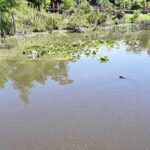
The Florida Department of Health in St. Johns County reported to Historic City News that it has issued a health alert after harmful blue-green algae toxins were detected in the St. Johns River near Shands Bridge. Residents are encouraged to take precautions as blue-green algae can have harmful effects on humans, pets, and other animals.
The alert followed an analysis of surface water samples, which revealed the presence of cyanotoxin. Pets should also be kept away, and residents should avoid eating shellfish from the water body in question. However, eating filets from healthy fish caught in freshwater lakes experiencing blooms is reportedly safe so long as they are rinsed and well-cooked and all guts are first disposed of.
“The public is warned not to drink, swim, wade, or use personal watercraft where there is visible blue-green algae bloom,” the Department of Health explained in a media release. “Blue-green algae are a type of bacteria that is common in Florida’s freshwater environments. A bloom occurs when rapid growth of algae leads to an accumulation of individual cells that discolor water and often produce floating mats that emit unpleasant odors.”
Some environmental factors that contribute to blue-green algae blooms are sunny days, warm water temperatures, still water conditions, and excess nutrients. Blooms can appear year-round but are more frequent in summer and fall. Many types of blue-green algae can produce toxins.
If you observe algae growing on a body of water in your area, you are encouraged to report it to the Florida Department of Environmental Protection. They will collect and analyzes algae bloom samples where indicated.
DEP can be reached at its toll-free hotline by calling 855-305-3903. An algae bloom reporting form is available and can be completed online.
Discover more from HISTORIC CITY NEWS
Subscribe to get the latest posts sent to your email.
